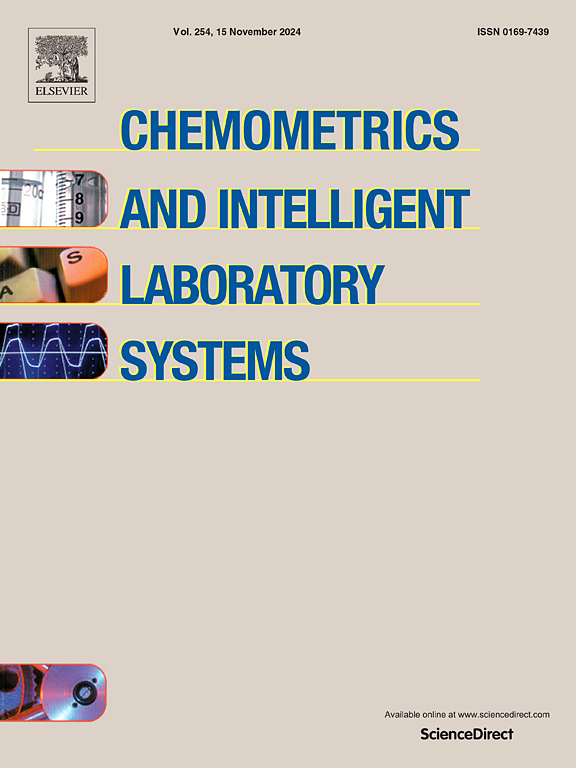Fused LassoNet: Sequential feature selection for spectral data with neural networks
IF 3.7
2区 化学
Q2 AUTOMATION & CONTROL SYSTEMS
Chemometrics and Intelligent Laboratory Systems
Pub Date : 2025-01-11
DOI:10.1016/j.chemolab.2024.105315
引用次数: 0
Abstract
Feature selection for high-dimensional spectral data is critical to improve the accuracy and interpretability of chemometric models. Various methods for feature selection have been introduced in chemometrics; however, achieving explainable sequential feature selection while conducting nonlinear classification simultaneously remains challenging. To address the challenge, this study proposes a fused least absolute shrinkage and selection operator network (LassoNet) that integrates the regularization principles of both the LassoNet and fused Lasso within the framework of a neural network. Further, the fused Lasso method facilitates continuous feature selection by considering the sequence between features, whereas LassoNet method enables nonlinear modeling using neural networks. We solve the fused LassoNet problem with proximal gradient descent, and the optimality of the proximal operator is mathematically proved. This study analyzes the performances of Lasso, fused Lasso, LassoNet, and fused LassoNet in classifying two groups using nine spectral datasets. The fused LassoNet demonstrates superior performance in terms of classification accuracy and sequential feature selection. These results demonstrate the proposed method enhances the predictive accuracy and interpretability of chemometric models using spectral data.
融合LassoNet:基于神经网络的光谱数据序列特征选择
高维光谱数据的特征选择对于提高化学计量模型的准确性和可解释性至关重要。化学计量学中介绍了各种特征选择方法;然而,在进行非线性分类的同时实现可解释的序列特征选择仍然具有挑战性。为了解决这一挑战,本研究提出了一种融合最小绝对收缩和选择算子网络(LassoNet),该网络在神经网络框架内集成了LassoNet和融合Lasso的正则化原则。此外,融合Lasso方法通过考虑特征之间的序列来实现连续特征选择,而LassoNet方法可以使用神经网络进行非线性建模。我们用近端梯度下降法解决了融合lasonet问题,并从数学上证明了近端算子的最优性。本文分析了Lasso、融合Lasso、lasonet和融合lasonet在使用9个光谱数据集进行两类分类时的性能。融合后的LassoNet在分类精度和序列特征选择方面表现出优异的性能。结果表明,该方法提高了光谱数据化学计量模型的预测精度和可解释性。
本文章由计算机程序翻译,如有差异,请以英文原文为准。
求助全文
约1分钟内获得全文
求助全文
来源期刊
CiteScore
7.50
自引率
7.70%
发文量
169
审稿时长
3.4 months
期刊介绍:
Chemometrics and Intelligent Laboratory Systems publishes original research papers, short communications, reviews, tutorials and Original Software Publications reporting on development of novel statistical, mathematical, or computer techniques in Chemistry and related disciplines.
Chemometrics is the chemical discipline that uses mathematical and statistical methods to design or select optimal procedures and experiments, and to provide maximum chemical information by analysing chemical data.
The journal deals with the following topics:
1) Development of new statistical, mathematical and chemometrical methods for Chemistry and related fields (Environmental Chemistry, Biochemistry, Toxicology, System Biology, -Omics, etc.)
2) Novel applications of chemometrics to all branches of Chemistry and related fields (typical domains of interest are: process data analysis, experimental design, data mining, signal processing, supervised modelling, decision making, robust statistics, mixture analysis, multivariate calibration etc.) Routine applications of established chemometrical techniques will not be considered.
3) Development of new software that provides novel tools or truly advances the use of chemometrical methods.
4) Well characterized data sets to test performance for the new methods and software.
The journal complies with International Committee of Medical Journal Editors'' Uniform requirements for manuscripts.

 求助内容:
求助内容: 应助结果提醒方式:
应助结果提醒方式:


